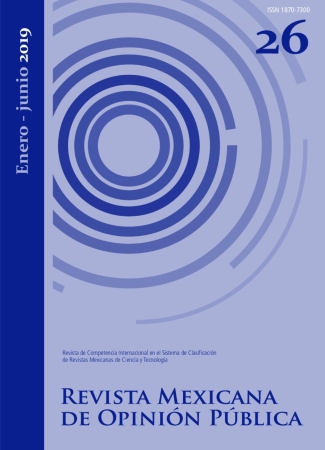Framing in Presidential Debate of the Peruvian Elections 2016 in Social Networks
Main Article Content
Abstract
The electoral debates have as one of their objectives to communicate the proposals of the candidates. Therefore, it is expected that the frames of the media, after this, will be, in a certain way, conditioned. However, in the Peruvian case, analyzing media publications on Facebook and Twitter, it is observed that strategic gaming frames continue to prevail, with little participation in the thematic. This study analyzes the publications on social networks carried out by the press, radio and television media, taking as a framework previous and subsequent cuts to the electoral debate of the second round of the Peruvian elections 2016.
Article Details
Citas en Dimensions Service
References
BARKER, Martín, “Stuart Hall, Controlando la Crisis”, Introducción a los estudios culturales, Bosch Comunicación, Barcelona, España, 1994, pp. 95-114.
DIMITROVA, Daniela y KOSTADINOVA, Petia, “Identifying Antecedents of the Strategic Game Frame. A Longitudinal Analysis”, Journalism & Mass Communication Quarterly, vol. 90, núm. 1, SAGE, Chicago, EE. UU., 2013, pp. 75-88. DOI: https://doi.org/10.1177/1077699012468739.
ECHEVERRÍA-VICTORIA, Martín y CHONG-LÓPEZ, Blanca, “Debates presidenciales y calidad de la democracia. Análisis empírico normativo de los debates mexicanos de 2012”, Palabra Clave, vol. 2, núm. 16, Universidad de La Sabana, Bogotá, Colombia, 2013, pp. 341-365. DOI: https://doi.org/10.5294/pacla.2013.16.2.3.
ENTMAN, Robert, “Framing.Toward Clarification of a Fractured Paradigm”, Journal of Communication, vol. 4, núm. 43, Oxford University Press, Washington D. C., EE. UU., 1993, pp. 51-58. DOI: https://doi.org/10.1111/j.1460-2466.1993.tb01304.x.
GAUTHIER, Gilles, “El análisis de contenido de los debates políticos televisados”, en Comunicación y Política, Gedisa, Barcelona, España 1998.
GAMSON, William, “The Social Psychology of Collective Action”, en Carol MCCLURG, Mueller y MORRIS, Aldon (Eds.), Frontiers in social movement theory, Yale University Press, Connecticut, EE. UU.,1992.
GITLIN, Todd, The Whole World Is Watching. Mass Media in the Making and Unmaking of the New Left, University of California Press, California, EE. UU., 2003. DOI: https://doi.org/10.1177/000271628145600152.
GOFFMAN, Erving, Frame Analysis. An Essay on the Organization of Experience, Northeastern University Press, Boston, EE. UU., 1986. DOI: https://doi.org/10.1176/ajp.132.10.1093-a.
IYENGAR, Shato, Is anyone responsible? How television frames political issues, University of Chicago Press, Chicago, EE. UU., 1994.
KANASHIRO, Lilian, Debates presidenciales televisados en el Perú (1990-2011). Una aproximación semiótica, Universidad de Lima, Lima, Perú, 2016.
KIOUSIS, Spiro, “Compelling Arguments and Attitude Strength. Exploring the Impact of Second-Level Agenda Setting on Public Opinion of Presidential Candidate Images”, The Harvard International Journal of Press/Politics, vol. 2, núm. 10, SAGE, Boston, EE. UU., 2005, pp. 3-27. DOI: https://doi.org/10.1177/1081180X05276095.
KOENEKE, Herbert, “El enmarcamiento (framing) o grupo céntrico en la campaña electoral venezolana de 1998”, Temas de comunicación, núm. 10, Universidad Católica Andrés Bello, Caracas, Venezuela, 2001, pp. 41-55.
KRAUS, Sidney, Televised Presidencital Debates and Public Policy, Routledge, Nueva Jersey, EE. UU., 2000. DOI: https://doi.org/10.1093/ijpor/12.3.333.
MACASSI, Sandro, “Los enmarcamientos como restrictores del espacio político”, ponencia, VIII Congreso Latinoamericano de Ciencia Política, ALACIP, Lima, Perú, 22-24 julio de 2015.
MATTHES, Jörg, “Framing Politics. An Integrative Approach”, American Behavioral Scientist, vol. 3, núm. 56, SAGE, California, EE. UU., 2012, pp. 247-259. DOI: https://doi.org/10.1177/0002764211426324.
MUÑIZ, Carlos, “La política como debate temático o estratégico. Framing de la campaña electoral mexicana de 2012 en la prensa digital”, Comunicación y Sociedad, núm. 23, Universidad de Guadalajara, Guadalajara, México, 2015, pp. 69-75.
RHEE, June Woong, “Strategy and Issue Frames in Election Campaign Coverage. A Social Cognitive Account of Framing Effects”, Journal of Communication, vol. 3, núm. 47, Oxford University Press, Washington D. C., EE. UU., 1997, pp. 26-48. DOI: https://doi.org/10.1111/j.1460-2466.1997.tb02715.x.
SCHROEDER, Alan, Presidential Debates. Fifty Years of High-Risk TV, Columbia University Press, Nueva York, EE. UU., 2008. DOI: https://doi.org/10.7312/schr14104.
SEMETKO, Holli y VALKENBURG, Patti “Framing European Politics. A Content Analysis of Press and Television News”, Journal of communication, vol. 2, núm. 50, Oxford University Press, Washington D. C, 2000, pp. 93-109. DOI: https://doi.org/10.1111/j.1460-2466.2000.tb02843.x.
STRÖMBÄCK Jesper y DIMITROVA, Daniela, “Mediatization and Media Interventionism: A Comparative Analysis of Sweden and the United States”, The International Journal of Press/Politics, vol. 16, núm. 1, SAGE, Oxford, Reino Unido, pp. 30-49. DOI: https://doi.org/10.1177/1940161210379504.
TÉLLEZ, Nilsa, MUÑIZ, Carlos y RAMÍREZ, Jacobo, “Función discursiva en los debates televisados. Un estudio transcultural de los debates políticos en México, España y Estados Unidos”, Palabra Clave, vol. 2, núm. 13, Universidad de La Sabana, Bogotá, Colombia, 2010, pp. 251-270. DOI: https://doi.org/10.5294/pacla.2010.13.2.2.
VERÓN, Eliseo, El cuerpo de las imágenes, Grupo Editorial Norma, Bogotá, Colombia, 2011.
VREESE, Claes de, “News Framing. Theory and Typology”, Information Design Journal, vol. 13, núm. 1, John Benjamins Publishing Company, Ámsterdam, Holanda, 2005, pp. 51-62. DOI: https://doi.org/10.1075/idjdd.13.1.06vre.

Revista Mexicana de Opinión Pública por Universidad Nacional Autónoma de México se distribuye bajo una Licencia Creative Commons Atribución-NoComercial-SinDerivar 4.0 Internacional.
Basada en una obra en http://revistas.unam.mx/index.php/rmop.
